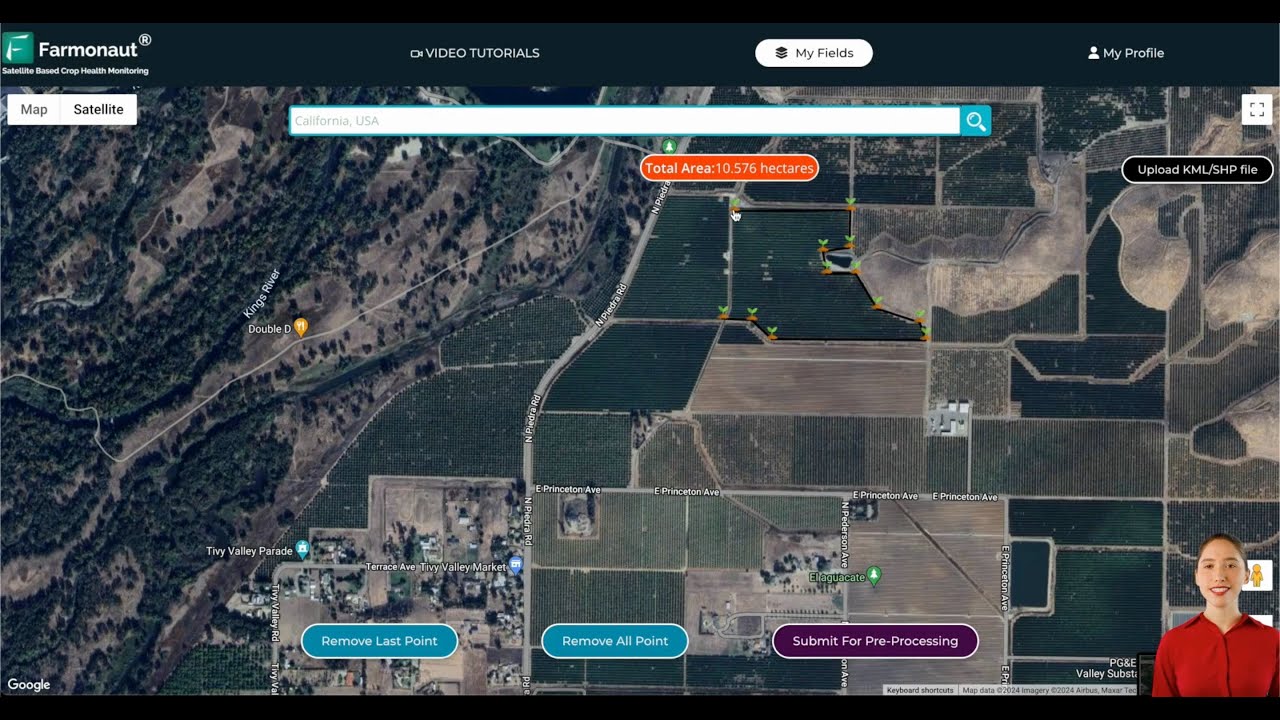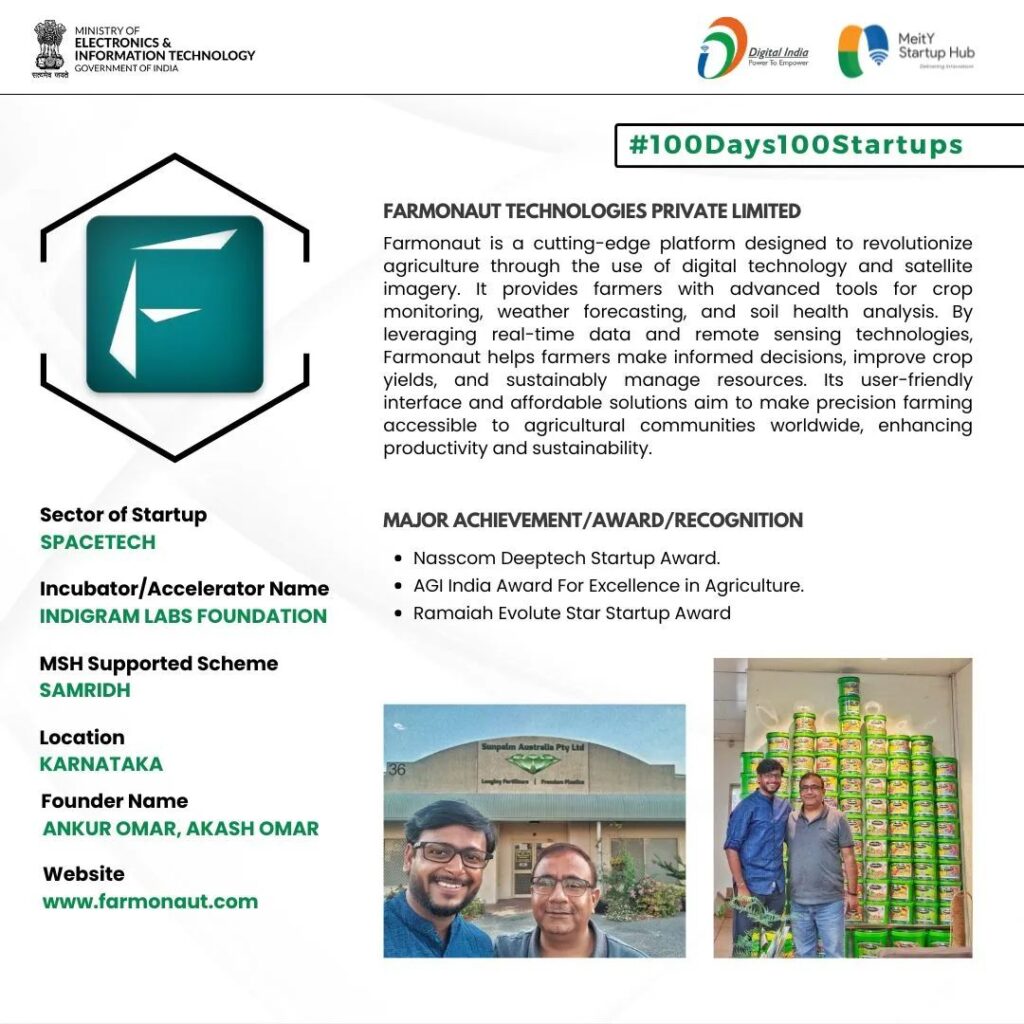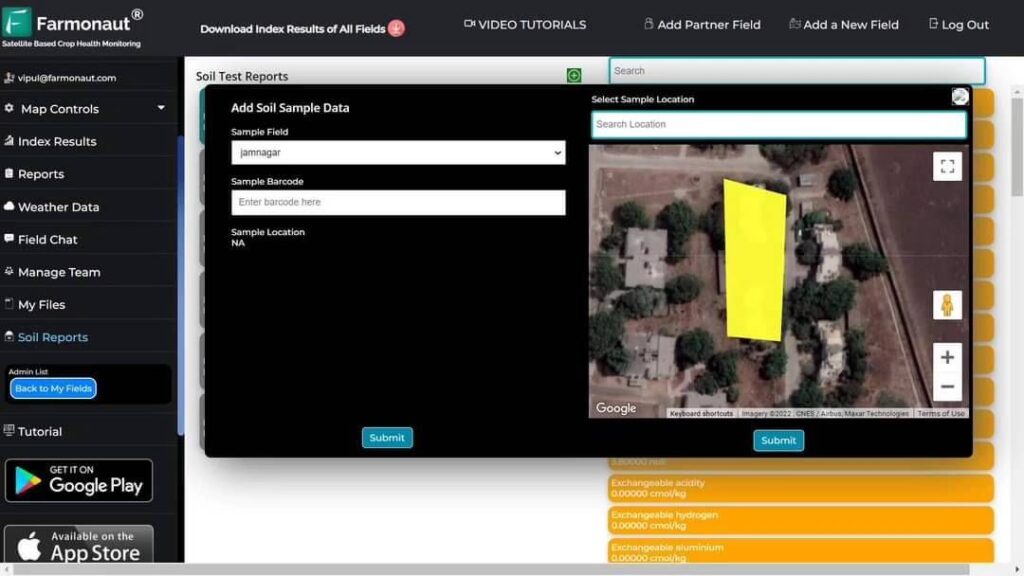Revolutionize Your Ranch: Farmonaut’s Precision Livestock Management Software for Sustainable Agriculture
“Farmonaut’s livestock management software offers over 10 features, including real-time grazing management and interactive farm mapping.”
In the ever-evolving landscape of modern agriculture, we at Farmonaut are proud to introduce our cutting-edge precision livestock management software. This revolutionary tool is designed to transform the way ranchers and farmers manage their livestock operations, enhancing efficiency, sustainability, and profitability. Our comprehensive digital ranch management solution combines advanced technology with practical, user-friendly features to address the complex needs of today’s agricultural industry.

The Power of Precision in Livestock Management
At the heart of our software lies a powerful suite of tools designed to revolutionize every aspect of livestock management. From interactive farm mapping to real-time grazing management systems, our platform offers a holistic approach to ranch operations. Let’s delve into the key features that make our software a game-changer in the industry:
- Interactive Farm Mapping: Our advanced mapping tools allow ranchers to visualize their entire operation from a bird’s eye view. By integrating satellite imagery with user-input data, we create detailed, interactive maps of your ranch, including paddocks, water sources, and infrastructure.
- Real-Time Grazing Management: Our software utilizes cutting-edge technology to monitor and optimize grazing patterns. By tracking livestock movements and pasture conditions, ranchers can make informed decisions about rotational grazing, helping to prevent overgrazing and promote sustainable land use.
- Comprehensive Animal Tracking: Keep tabs on your entire herd with our robust animal tracking system. From individual animal health records to herd-wide performance metrics, our software provides a complete picture of your livestock at your fingertips.
- Data-Driven Insights: Harness the power of agricultural data analytics to drive your decision-making process. Our software collects and analyzes data on various aspects of your operation, providing valuable insights into productivity, efficiency, and areas for improvement.
By integrating these features into a single, user-friendly platform, we’ve created a powerful tool that empowers ranchers to take control of their operations like never before.
Optimizing Pasture Management for Sustainable Growth
Effective pasture management is crucial for maintaining healthy livestock and ensuring the long-term sustainability of your ranch. Our precision livestock management software offers a range of features designed to optimize your pasture utilization and forage production:
- Paddock Utilization Tracking: Monitor the use of each paddock in real-time, ensuring optimal rotation and rest periods for your pastures.
- Stocking Rate Calculator: Determine the ideal number of animals for each paddock based on current forage availability and projected growth rates.
- Forage Production Forecasting: Utilize historical data and current conditions to predict future forage production, allowing for proactive management decisions.
- Grazing Intensity Monitoring: Track the impact of grazing on your pastures, helping to prevent overgrazing and promote sustainable land use practices.
By providing these tools, we enable ranchers to make data-driven decisions that balance livestock needs with pasture health, ultimately leading to more sustainable and profitable operations.
Streamlining Livestock Record-Keeping and Reporting
Accurate and comprehensive record-keeping is essential for any successful livestock operation. Our software simplifies this process, offering:
- Digital Health Records: Maintain detailed health records for each animal, including vaccinations, treatments, and health events.
- Performance Tracking: Monitor key performance indicators such as weight gain, feed conversion rates, and reproductive efficiency.
- Inventory Management: Keep track of your herd composition, births, deaths, and transfers with ease.
- Compliance Reporting: Generate reports for regulatory compliance and certification requirements with just a few clicks.
By digitizing and centralizing your livestock records, we help you save time, reduce errors, and make more informed management decisions.
Enhancing Operational Efficiency with Task Management
Efficient task management is key to running a successful ranch. Our software includes robust task management features designed to streamline your daily operations:
- Calendar Integration: Schedule and track all ranch activities in a centralized calendar system.
- Task Assignment: Assign tasks to team members and track their completion status in real-time.
- Automated Reminders: Set up reminders for recurring tasks such as vaccinations, pasture rotations, and equipment maintenance.
- Mobile Access: Manage tasks on-the-go with our mobile app, ensuring you’re always connected to your operation.
By improving task management, we help ranchers optimize their workflows, reduce inefficiencies, and ensure that critical activities are never overlooked.
“The platform’s comprehensive approach covers management of multiple livestock types, from sheep to cattle, enhancing overall farm efficiency.”
Driving Profitability through Data Analytics
In today’s competitive agricultural landscape, data-driven decision-making is crucial for maintaining profitability. Our precision livestock management software offers powerful analytics tools to help you make informed business decisions:
- Cost Tracking: Monitor input costs, including feed, veterinary expenses, and labor, to identify areas for potential savings.
- Production Analysis: Analyze production data to identify your most profitable animals and management practices.
- Market Insights: Access up-to-date market information to help you make informed decisions about when to buy or sell.
- Scenario Planning: Use our modeling tools to explore the potential impacts of different management strategies on your bottom line.
By leveraging these analytics capabilities, ranchers can identify opportunities for improvement, optimize their operations, and ultimately increase their profitability.
Embracing Sustainable Agriculture with Farmonaut
At Farmonaut, we believe that sustainable agriculture is not just an option, but a necessity for the future of farming. Our precision livestock management software is designed with sustainability in mind, offering features that promote environmentally responsible ranching practices:
- Resource Optimization: By providing detailed insights into pasture conditions and livestock needs, our software helps ranchers optimize their use of natural resources, reducing waste and environmental impact.
- Carbon Footprint Tracking: Monitor and manage your ranch’s carbon footprint with our integrated carbon tracking tools, helping you meet sustainability goals and potentially access carbon credit markets.
- Biodiversity Monitoring: Track and promote biodiversity on your ranch by monitoring plant species diversity and wildlife habitats.
- Soil Health Management: Utilize our soil health monitoring features to maintain and improve soil quality, ensuring long-term sustainability of your pastures.
By incorporating these sustainability-focused features, we empower ranchers to not only improve their bottom line but also contribute to a more sustainable future for agriculture.
Seamless Integration for Comprehensive Farm Management
Our precision livestock management software is designed to integrate seamlessly with other aspects of your farm operation, providing a comprehensive solution for modern agriculture:
- Crop Management Integration: For mixed operations, our software integrates livestock management with crop production data, allowing for holistic farm planning.
- Equipment Tracking: Monitor the use and maintenance of your farm equipment alongside your livestock management tasks.
- Financial Management: Integrate with popular accounting software to streamline financial reporting and analysis.
- Weather Data: Incorporate real-time weather data to inform grazing and pasture management decisions.
This integrated approach ensures that all aspects of your farm operation work in harmony, maximizing efficiency and profitability.

User-Friendly Interface for All Levels of Tech Proficiency
We understand that technology adoption can be challenging, especially in traditional farming environments. That’s why we’ve designed our software with a user-friendly interface that caters to all levels of tech proficiency:
- Intuitive Design: Our software features a clean, intuitive design that makes navigation and data input simple and straightforward.
- Customizable Dashboards: Users can customize their dashboards to display the information most relevant to their specific operations.
- Mobile Compatibility: Access your ranch data on-the-go with our mobile-responsive design, compatible with both iOS and Android devices.
- Training and Support: We offer comprehensive training resources and responsive customer support to ensure you get the most out of our software.
By prioritizing user experience, we ensure that ranchers of all backgrounds can harness the power of precision agriculture technology.
Comparing Traditional and Precision Livestock Management
To fully appreciate the revolutionary nature of our precision livestock management software, let’s compare it to traditional methods:
| Management Aspect | Traditional Methods | Farmonaut’s Precision Approach |
|---|---|---|
| Animal Tracking | Manual counting and visual identification | Real-time GPS tracking and digital ID systems |
| Pasture Management | Visual assessment and experience-based decisions | Data-driven analysis of pasture conditions and utilization |
| Data Analytics | Limited manual record-keeping and analysis | Comprehensive data collection and advanced analytics |
| Grazing Management | Fixed rotational schedules | Dynamic, data-informed grazing plans |
| Record Keeping | Paper-based or basic spreadsheets | Centralized digital records with easy access and analysis |
| Paddock Utilization | Subjective assessment | Objective measurement and optimization |
| Stocking Rates | Based on historical norms | Dynamically adjusted based on real-time data |
| Forage Production | Estimated based on past experience | Predicted using advanced modeling and current data |
| Task Management | Manual scheduling and tracking | Automated reminders and digital task assignment |
| Reporting and Compliance | Time-consuming manual report generation | Automated report generation and compliance tracking |
As this comparison clearly illustrates, our precision livestock management software offers significant advantages over traditional methods in every aspect of ranch management.
Empowering Ranchers with Actionable Insights
One of the most powerful aspects of our precision livestock management software is its ability to transform raw data into actionable insights. Here’s how we help ranchers make informed decisions:
- Predictive Analytics: Our software uses historical data and current trends to predict future outcomes, allowing ranchers to proactively address potential issues.
- Performance Benchmarking: Compare your ranch’s performance against industry standards and your own historical data to identify areas for improvement.
- Decision Support Tools: Our software provides recommendations based on your specific data, helping you make optimal decisions for your unique situation.
- Custom Reporting: Generate tailored reports that focus on the metrics most important to your operation, facilitating better decision-making at all levels.
By providing these insights, we empower ranchers to make data-driven decisions that can significantly improve their overall farm performance.
Enhancing Compliance and Traceability
In today’s agricultural landscape, compliance with regulations and traceability of livestock are increasingly important. Our software helps ranchers meet these challenges:
- Regulatory Compliance: Our software is designed to help you meet various regulatory requirements, with built-in features for tracking and reporting on key compliance metrics.
- Animal Traceability: Maintain detailed records of animal movements and treatments, ensuring full traceability from birth to market.
- Audit Preparation: Generate comprehensive reports that make preparing for audits a breeze, saving time and reducing stress.
- Quality Assurance: Our software helps you implement and track quality assurance programs, enhancing the value of your livestock.
By streamlining compliance and traceability, we help ranchers meet regulatory requirements while also adding value to their products.
Frequently Asked Questions
To help you better understand our precision livestock management software, here are answers to some frequently asked questions:
- Q: Is Farmonaut’s software suitable for small-scale ranchers?
A: Absolutely! Our software is designed to be scalable, catering to operations of all sizes, from small family farms to large commercial ranches. - Q: Do I need special equipment to use Farmonaut’s software?
A: No special equipment is required. Our software is cloud-based and can be accessed from any device with an internet connection. - Q: How secure is my farm data?
A: We take data security very seriously. All data is encrypted and stored securely, with strict access controls in place. - Q: Can Farmonaut’s software integrate with my existing farm management tools?
A: Yes, our software is designed to integrate with a wide range of farm management tools and financial software. - Q: Is training provided for using the software?
A: Yes, we offer comprehensive training resources, including video tutorials, user guides, and live support to help you get the most out of our software.
Ready to Revolutionize Your Ranch?
Farmonaut’s precision livestock management software is more than just a tool – it’s a complete solution for modern ranchers looking to optimize their operations, increase profitability, and embrace sustainable agriculture practices. By combining cutting-edge technology with user-friendly design, we’ve created a platform that can truly revolutionize your ranch.
Whether you’re managing a small herd of sheep or a large cattle operation, our software provides the insights and tools you need to make informed decisions, streamline your workflows, and drive your business forward. With features ranging from interactive farm mapping to comprehensive animal tracking and powerful data analytics, we offer a holistic approach to livestock management that sets a new standard in the industry.
Are you ready to take your ranch to the next level? Explore Farmonaut’s precision livestock management software today and discover how we can help you achieve your goals for efficiency, sustainability, and profitability.
Get started with Farmonaut:
For developers interested in integrating our powerful features into their own applications, check out our API and API Developer Docs.
Join the precision agriculture revolution with Farmonaut and transform the way you manage your livestock operation. The future of sustainable, efficient, and profitable ranching is here – are you ready to embrace it?




















